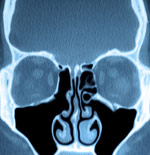Nasal & Sinus Surgery
Nasal and sinus surgery may be performed for several reasons. There are many disorders of the nose and sinuses that may cause symptoms for the patient. These symptoms include:
- nasal obstruction (mouth breathing)
- postnasal drip
- chronic headaches
- recurrent sinus infections
Nasal obstruction
Nasal obstruction may be caused by a:
- Deviated septum (congenital, traumatic, etc)
- Large turbinates (congenital, allergies, etc)
Treatment- typically includes oral or nasal decongestants. If these fail, minor surgery may be recommended
When should surgery be considered to correct a chronically stuffy nose?
Millions of Americans perennially suffer the discomfort of nasal stuffiness. This may be indicative of chronic breathing problems that don’t respond well to ordinary treatment. The blockage may be related to structural abnormalities inside the nose or to swelling caused by allergies or viruses.
Deviated Septum
There are numerous causes of nasal obstruction. A deviated septum (the partition between the nostrils) can be crooked or bent as the result of abnormal growth or injury. This can partially or completely close one or both nasal passages. The deviated septum can be corrected with a surgical procedure called septoplasty. Cosmetic changes to the nose are often performed at the same time, in a combination procedure called septorhinoplasty.
Turbinate Hypertrophy
Overgrowth of the turbinates is another cause of stuffiness. (The turbinates are the tissues that line the inside of the nasal passages.) Sometimes the turbinates need treatment to make them smaller and expand the nasal passages. Treatments include injection, freezing, and partial removal. Allergies, too, can cause internal nasal swelling, and allergy evaluation and therapy may be necessary.
What treatment is needed for a broken nose?
Bruises around the eyes and/or a slightly crooked nose following injury usually indicate a fractured nose. If the bones are pushed over or out to one side, immediate medical attention is ideal. But once soft tissue swelling distorts the nose, waiting 48-72 hours for a doctor’s appointment may actually help the doctor in evaluating your injury as the swelling recedes. (Apply ice while waiting to see the doctor.)
For details on broken nose and its treatment, you may read more here.
Can surgery correct a stuffy, aging nose?
Aging is a common cause of nasal obstruction. This occurs when cartilage in the nose and its tip are weakened by age and droop because of gravity, causing the sides of the nose to collapse inward, obstructing air flow. Mouth breathing or noisy and restricted breathing are common.
Try lifting the tip of your nose to see if you breathe better. If so, talk to a facial plastic surgeon/otolaryngologist about a possible surgical repair for this problem.
Will insurance cover nasal surgery?
Insurance usually does not cover cosmetic surgery. However, surgery to correct or improve breathing function, major deformity, or injury is frequently covered in whole or in part. Patients should obtain cost information from their surgeons and discuss with their insurance carrier prior to surgery.
If you are interested in learning more about the services offered at the Nasal and Sinus Center at OHNI, please call us today to schedule an appointment.
Virtual & Office Appointments Available




